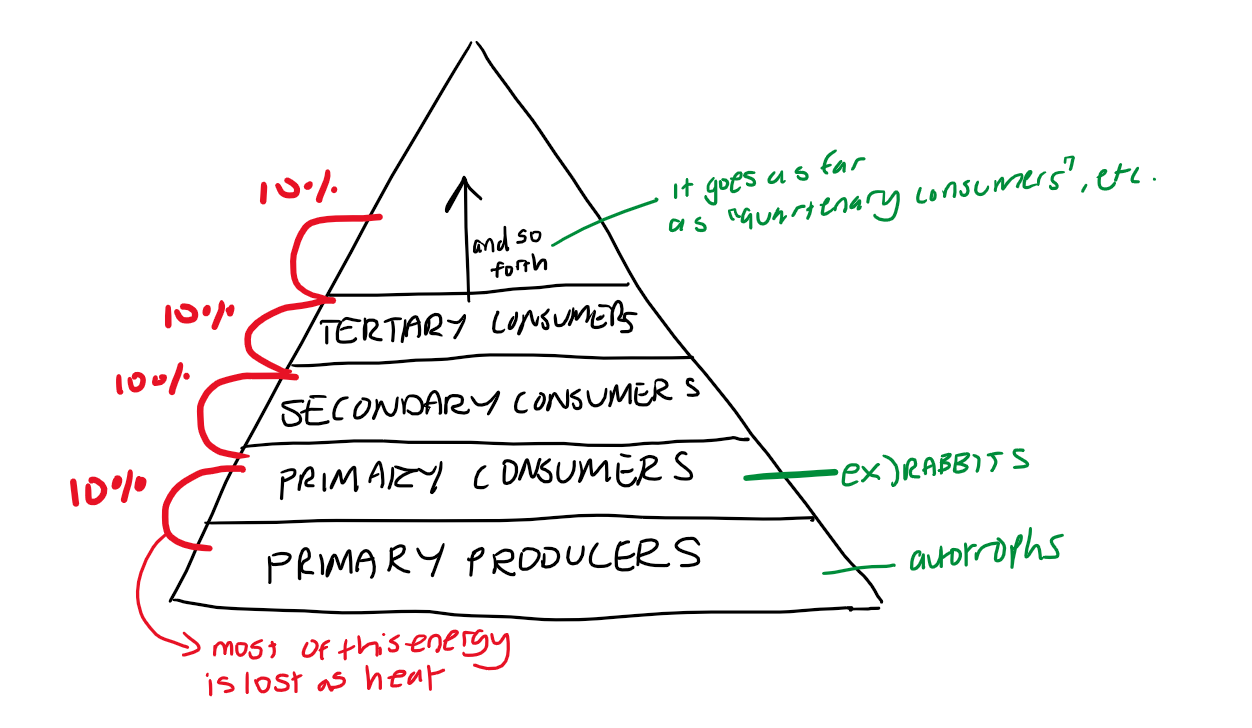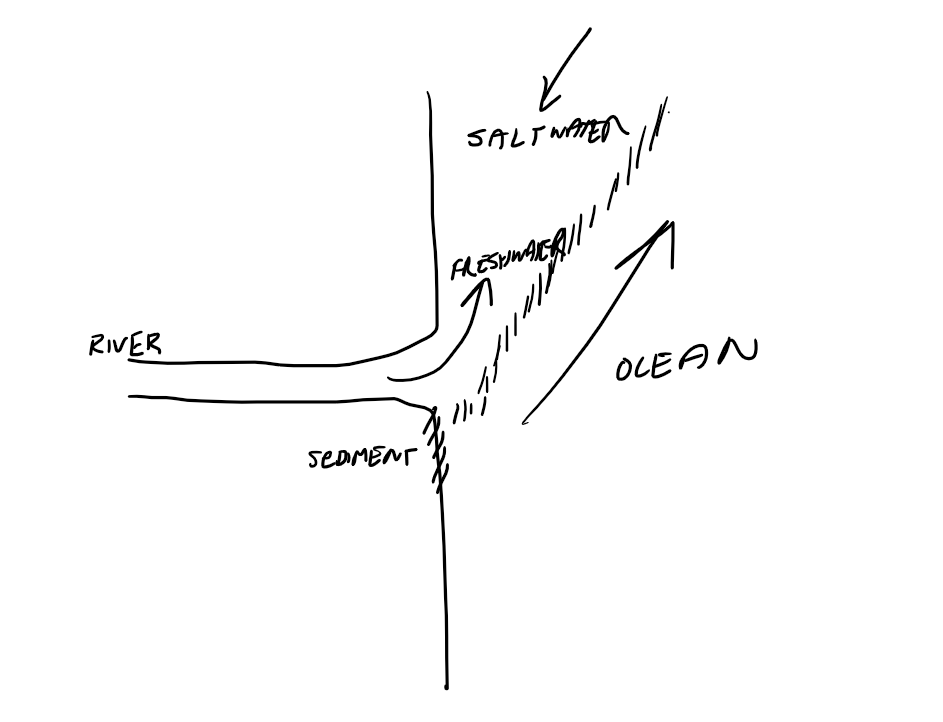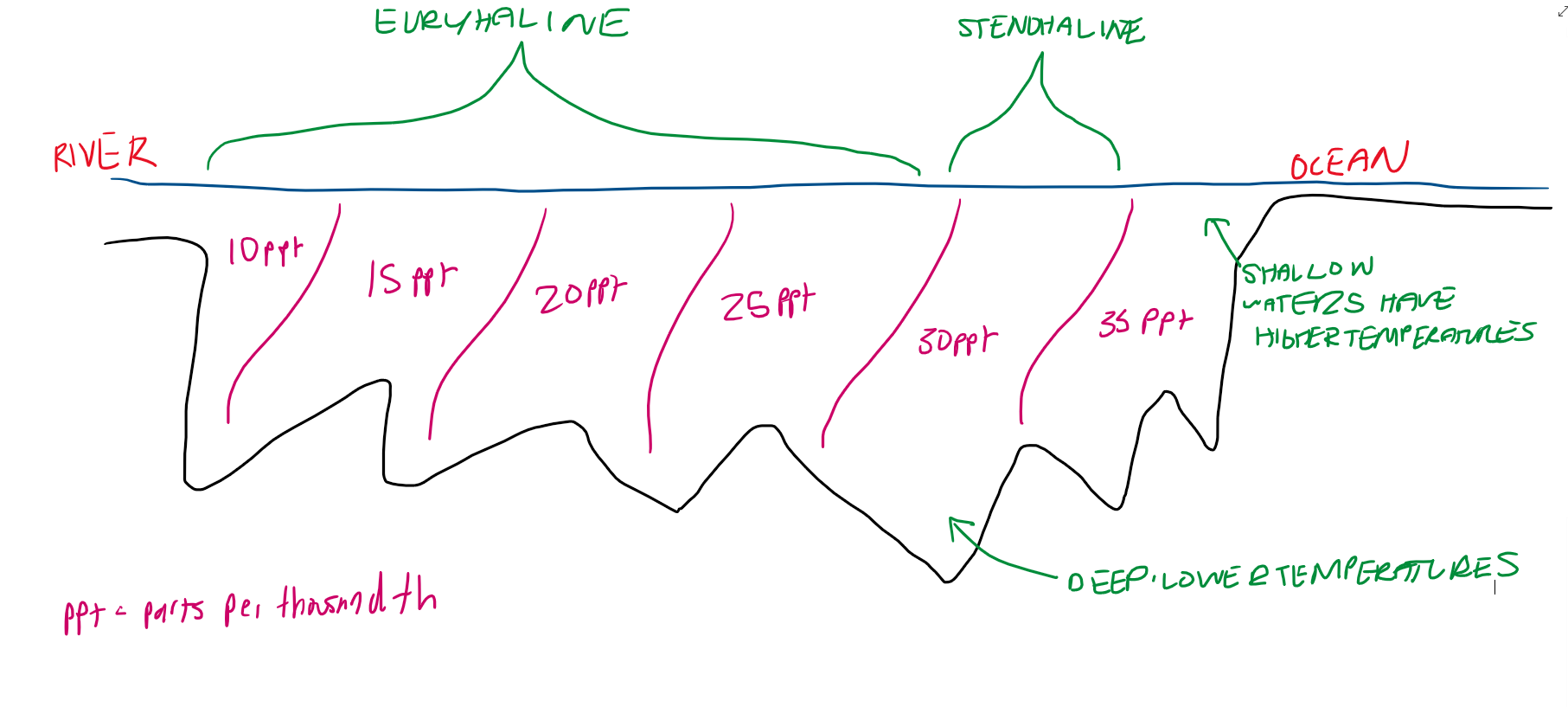
Marine Ecology/Estuaries
Ecology: The study of how organisms interact with each other and the environment
Most are connected to some form of energy
Autotrophs: Organisms that can create their own energy
Photoautotrophs: Use light
Chemoautotrophs: Use chemicals
Heterotrophs: Organisms that must consume other organisms for energy
LEVELS
Species: An organism that creates a viable offspring
Critical that their offspring can also produce offspring
Population: A group of organisms of the same species living in the same place at the same time
Communities: Various populations (multiple species) in a general area
Ecosystem: All the communities and all of the physical features of the environment
ENERGY PYRAMID

90% of the energy is lost as heat
The best way to be efficient in getting more energy is by being at the bottom of the pyramid
This is why the most abundant organisms tend to be primary producers/towards the bottom
Intraspecific competition: Competition between organisms of the same species
Competitive exclusion: When one organism outcompetes the other for resources
Competitive exclusion is the most common outcome
Resource partitioning: Sharing the resources amongst themselves
Less common
Sharing the resources in different ways or at different times
EX) Giraffes eat leaves at the top of a tree while an impala feeds on leaves at the bottom
INTERACTIONS THAT HAVE LED TO CO-EVOLUTION
Symbiont: Something that has developed a long-term relationship with another organism. Tend to be smaller than the host.
Mutualism: When the symbiont and the host both benefit from the relationship (+, +)
EX) Clownfish and other sea anemone provides protection for clownfish, clownfish clean off debris/provides nutrients
Commensalism: One organism is benefitting while the other is unharmed (+, 0)
EX) Sharks and Remora-- Remora stick to shark underbellies to get free transportation. The sharks are unharmed for the most part. An exception is when the remora grow too big and sink the shark down.
Parasitism: Symbiont benefits and the host is harmed in some way (+, -)
Greenland sharks and copepods-- referred to as ommatokoita: The parasite latches onto the shark’s eye, destroying its corneal tissue to go after its blood source, rendering the shark blind and destroying their immune system in the process
ESTUARIES
Estuary: A low-lying area that gets both freshwater and seawater mixed into it
Tends to have a large accumulation of sediment because they often are cut off from the ocean (no waves)
Usually you would find fine sediment like mud and clay
A nursery ground for ALL types of organisms
Invertebrates, fish, sharks, marine birds, etc.
However, NO marine mammals
Mainly because there are no waves, etc. If they are in an estuary, they’re likely sick
Rest stop for migrating birds
Less so nowadays because of human development
Highly polluted because of cities upstream that dispose of trash
Acts as a filler for the ocean because all of the pollutants settle in the estuaries
4 TYPES OF ESTUARIES
Coastal Plane Estuary
The most common type of estuary
It is right next to the ocean and low-lying enough that it fills up during the high tide
EX) Bolsa Chica Estuary in California, USA
Tectonic Estuary
Results from sinking land due to earthquakes
Earth’s tectonic plates run into/fold up underneath each other, creating depressions
Steep-walled river valleys created by the advancing glaciers
EX) San Francisco Bay
Bar-built estuaries
Accumulation of sand that cuts off rivers from the ocean
Streams or rivers flowing into bar-built estuaries typically have a low water volume during most of the year

Fjord
Results from sinking land due to glaciers
The glaciers carve out a deep, steep valley
Glaciers retreat/the ocean rushes in to fill the narrow, deep depression
MAIN CHARACTERISTICS OF AN ESTUARY
Sediment
Fine sediment
Takes a long time to settle out
Turbidity is very high
Not much sunlight penetrates through the sediment
As a result, there is not much algae or plant growth in the water
Salinity
During low tides: More freshwater
During high tides: More saltwater
Stenohaline: Can tolerate small changes in salinity
Euryhaline: Can tolerate large changes in salinity
Temperatures
Temperature fluctuations normally due to the shape of the estuary
Freshwater tends to be colder than saltwater

REGIONS OF AN ESTUARY
Water Habitat
Largest habitat in an estuary
Typically where most organisms are found, but usually the diversity isn’t that high in comparison to other habitats
However, the abundance of those organisms is greatly increased
Marsh Habitat
Where all the plants are found at the edge
Where all marine plants are found
These habitats are in charge of removing pollution from the water
Mudflats
The smallest of the habitats
Are only visible during the low tide
The only way that prober-type birds can feed
Primary production of bacteria and microscopic algae
Marine Ecology/Estuaries
Ecology: The study of how organisms interact with each other and the environment
Most are connected to some form of energy
Autotrophs: Organisms that can create their own energy
Photoautotrophs: Use light
Chemoautotrophs: Use chemicals
Heterotrophs: Organisms that must consume other organisms for energy
LEVELS
Species: An organism that creates a viable offspring
Critical that their offspring can also produce offspring
Population: A group of organisms of the same species living in the same place at the same time
Communities: Various populations (multiple species) in a general area
Ecosystem: All the communities and all of the physical features of the environment
ENERGY PYRAMID

90% of the energy is lost as heat
The best way to be efficient in getting more energy is by being at the bottom of the pyramid
This is why the most abundant organisms tend to be primary producers/towards the bottom
Intraspecific competition: Competition between organisms of the same species
Competitive exclusion: When one organism outcompetes the other for resources
Competitive exclusion is the most common outcome
Resource partitioning: Sharing the resources amongst themselves
Less common
Sharing the resources in different ways or at different times
EX) Giraffes eat leaves at the top of a tree while an impala feeds on leaves at the bottom
INTERACTIONS THAT HAVE LED TO CO-EVOLUTION
Symbiont: Something that has developed a long-term relationship with another organism. Tend to be smaller than the host.
Mutualism: When the symbiont and the host both benefit from the relationship (+, +)
EX) Clownfish and other sea anemone provides protection for clownfish, clownfish clean off debris/provides nutrients
Commensalism: One organism is benefitting while the other is unharmed (+, 0)
EX) Sharks and Remora-- Remora stick to shark underbellies to get free transportation. The sharks are unharmed for the most part. An exception is when the remora grow too big and sink the shark down.
Parasitism: Symbiont benefits and the host is harmed in some way (+, -)
Greenland sharks and copepods-- referred to as ommatokoita: The parasite latches onto the shark’s eye, destroying its corneal tissue to go after its blood source, rendering the shark blind and destroying their immune system in the process
ESTUARIES
Estuary: A low-lying area that gets both freshwater and seawater mixed into it
Tends to have a large accumulation of sediment because they often are cut off from the ocean (no waves)
Usually you would find fine sediment like mud and clay
A nursery ground for ALL types of organisms
Invertebrates, fish, sharks, marine birds, etc.
However, NO marine mammals
Mainly because there are no waves, etc. If they are in an estuary, they’re likely sick
Rest stop for migrating birds
Less so nowadays because of human development
Highly polluted because of cities upstream that dispose of trash
Acts as a filler for the ocean because all of the pollutants settle in the estuaries
4 TYPES OF ESTUARIES
Coastal Plane Estuary
The most common type of estuary
It is right next to the ocean and low-lying enough that it fills up during the high tide
EX) Bolsa Chica Estuary in California, USA
Tectonic Estuary
Results from sinking land due to earthquakes
Earth’s tectonic plates run into/fold up underneath each other, creating depressions
Steep-walled river valleys created by the advancing glaciers
EX) San Francisco Bay
Bar-built estuaries
Accumulation of sand that cuts off rivers from the ocean
Streams or rivers flowing into bar-built estuaries typically have a low water volume during most of the year

Fjord
Results from sinking land due to glaciers
The glaciers carve out a deep, steep valley
Glaciers retreat/the ocean rushes in to fill the narrow, deep depression
MAIN CHARACTERISTICS OF AN ESTUARY
Sediment
Fine sediment
Takes a long time to settle out
Turbidity is very high
Not much sunlight penetrates through the sediment
As a result, there is not much algae or plant growth in the water
Salinity
During low tides: More freshwater
During high tides: More saltwater
Stenohaline: Can tolerate small changes in salinity
Euryhaline: Can tolerate large changes in salinity
Temperatures
Temperature fluctuations normally due to the shape of the estuary
Freshwater tends to be colder than saltwater

REGIONS OF AN ESTUARY
Water Habitat
Largest habitat in an estuary
Typically where most organisms are found, but usually the diversity isn’t that high in comparison to other habitats
However, the abundance of those organisms is greatly increased
Marsh Habitat
Where all the plants are found at the edge
Where all marine plants are found
These habitats are in charge of removing pollution from the water
Mudflats
The smallest of the habitats
Are only visible during the low tide
The only way that prober-type birds can feed
Primary production of bacteria and microscopic algae
 Knowt
Knowt